[ad_1]
“Is flexibility important for being fit?”
There’s a question that flummoxes many fitness fanatics.
Many people believe that increasing your flexibility reduces your risk of injury, boosts your athletic performance, and helps you recover more efficiently.
But how important is flexibility, really?
Is being limber really part and parcel of being fit, like strength, muscle mass, and endurance, or is it more incidental?
Learn the answer in this article.
Why Is Flexibility Important?
Flexibility is an important part of fitness, but not for the reasons most people think.
The main reasons most people stretch are to reduce their risk of injury and improve their performance and recovery, but it’s not particularly effective for any of these purposes.
For instance, studies show that stretching . . .
Admittedly, there are simple ways to avoid these pitfalls, which we’ll talk about soon.
Many people also assume that there’s something inherently healthy about being extremely flexible, probably because many sedentary people are inflexible and stiff, and thus they equate flexibility with improved fitness.
While this isn’t entirely offbase, it’s also somewhat misguided, as there are many out of shape people who are very flexible. What’s more, improving your flexibility doesn’t move the needle when it comes to most of the positive outcomes we’re after in the gym (less body fat, more muscle, better insulin sensitivity, and so forth).
The real reason flexibility is important is you need a certain amount of it to perform various exercises properly, especially fundamental strength-training exercises like the squat, deadlift, and bench and overhead press.
Studies show that strength training is actually about as effective as stretching for improving flexibility, but many people find that doing a handful of stretches produces even better results.
You can think of stretching as a “supplement” of sorts for your muscles and joints—it won’t make you “fitter” on its own, but it can help you get a bit more out of your workouts, if a lack of flexibility makes it hard for you to perform certain exercises properly.
Types of Stretching
To implement a stretching regimen into your health and fitness routine, it’s important to learn the different types of stretching and how to use each.
Static Stretching
A static stretch is any kind of stretch where you hold a position for an extended period (generally 15 or more seconds), with the intention of improving your flexibility.
Static stretches can be “active,” where you stretch one muscle by contracting another without using any external load (flexing your calf muscles to stretch your ankles, for instance), or “passive,” where you use external force such as a partner or resistance band to intensify the stretch (grabbing your toes and pulling your torso toward the floor).
Dynamic Stretching
A dynamic stretch involves moving a limb through a full range of motion until it’s stretched, then repeating the movement several times.
People often use dynamic stretches before they play a sport or do a workout to “limber up,” and the stretches they use typically resemble the movements that they’re about to perform.
For example, before a squat workout, a weightlifter might perform multiple sets of bodyweight squats to loosen up their lower body and stretch their quads, hamstrings, hip flexors, and so forth.
Dynamic stretches can also be performed “ballistically,” which involves rapidly bouncing at the end-range of motion, but this isn’t recommended as it may lead to injury.
PNF Stretching
Proprioceptive neuromuscular facilitation (PNF) stretches involve contracting a muscle (or its “antagonist”) before stretching it. There are three main types of PNF stretches: “contract relax,” “hold relax,” and “contract-relax agonist contract.”
Research shows that PNF stretching is effective at increasing flexibility when you perform it regularly, though many PNF stretches require a partner, so it isn’t a viable option for some people.
The Right Way to Stretch
As we’ve already seen, stretching can be more of a hindrance than a help if you do it “incorrectly.”
Fortunately, learning to stretch the right way isn’t difficult. Here are a few rules of thumb to make your stretching more effective.
That said, if you like stretching before you train to feel “looser,” research shows you can negate stretching’s adverse effects by keeping your stretches short and at a low intensity.
For example, if you’re warming up for a leg workout, perform a series of static and dynamic stretches for your quads, hamstrings, glutes, and calves, holding each stretch for a maximum of 20 seconds, and only to the point of very mild discomfort—around a 5 or 6 on a scale of 1-to-10.
- Wait 24 hours to stretch a trained muscle: When it comes to stretching for recovery, avoid stretching a muscle you’ve trained in the last 24 hours. To aid muscle recovery after that, stretch your muscles using a maximum intensity of 3-to-4 out of 10 for less than 30 seconds.
- Stretch two-to-three times per week, preferably on rest days or several hours after training: The best way to improve your flexibility without hindering your performance is to stretch away from training, so try to schedule your stretching sessions on rest days or several hours after your workouts.
The American College of Sports Medicine recommends stretching each muscle 2-to-3 times per week for 10-to-30 seconds per stretch to the point of slight discomfort, accumulating 60 total seconds per muscle, and these are sound recommendations.
How to Become More Flexible
To improve full-body flexibility, a combination of upper- and lower-body yoga poses tends to work best. Here are 10 that are highly effective.
Do these stretches at least an hour away from your workouts, hold each position for 30-to-60 seconds, and push yourself to the point of mild discomfort, but not pain.
1. Thunderbolt Pose
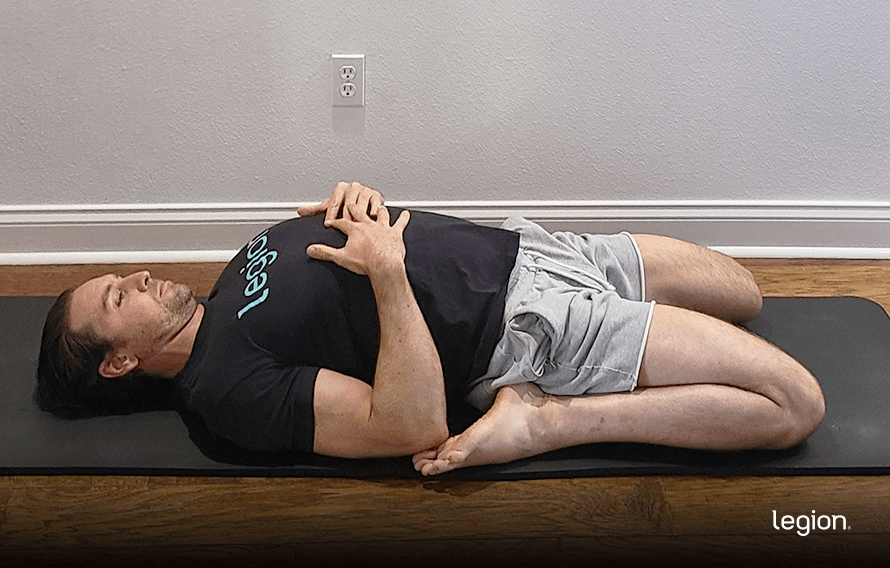
This is an outstanding exercise for improving the flexibility of your hips, thighs, lower back, and ankles. After several weeks of doing this stretch regularly, you should see significant improvements in your lower-body range of motion.
2. One-Leg Reclined Thunderbolt Pose
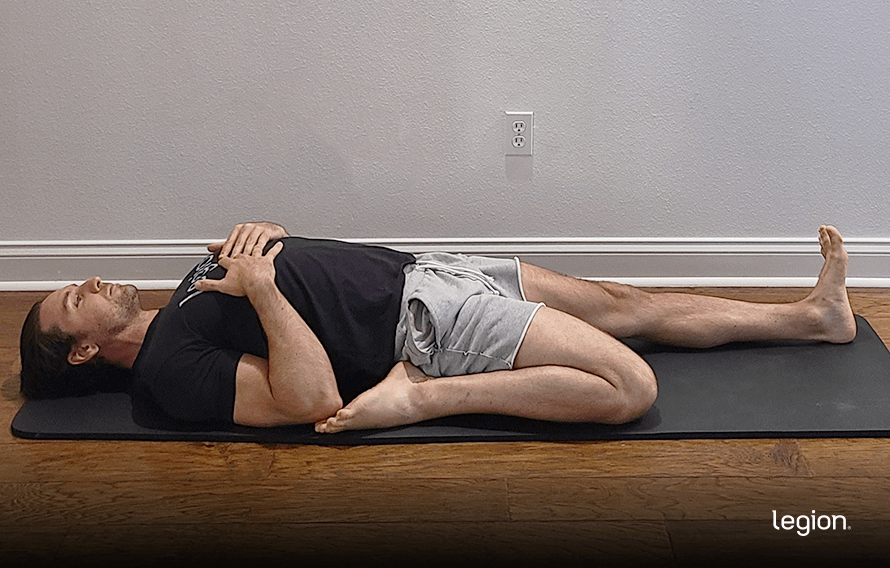
This pose increases the flexibility of pretty everything from your hips down. However, because you stretch each leg independently, it allows for a deeper stretch and helps you to identify and even out any flexibility imbalances you may have.
3. Pigeon Pose
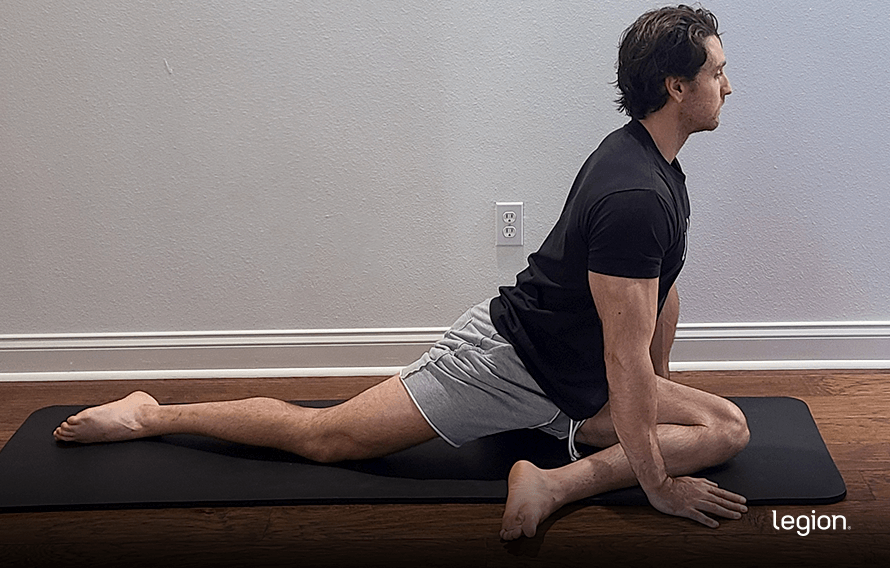
This pose “opens up” the muscles on the outside of your thighs and hips (the hip abductors) which can get tight if you do a lot of lower-body training or stay seated for long periods each day.
4. Eye of the Needle Pose
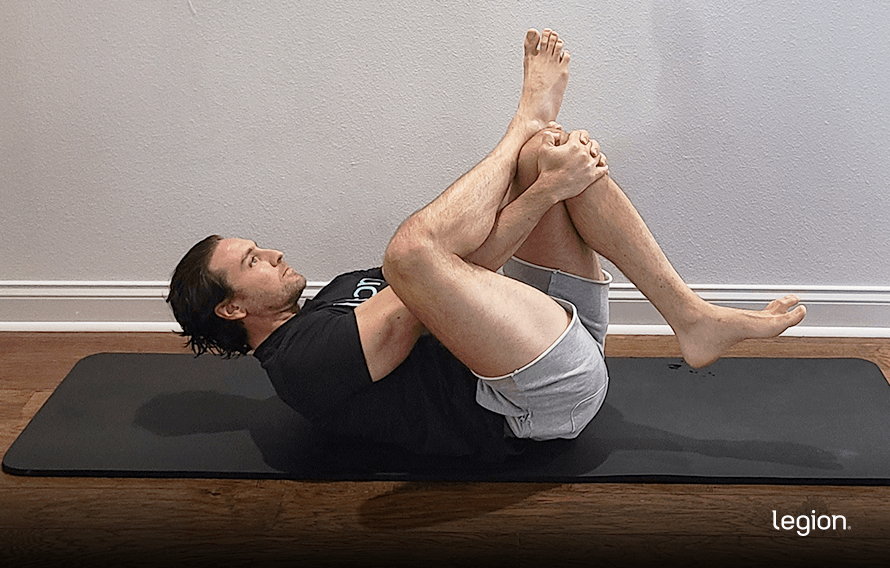
This pose loosens the glutes, low-back, and outside of the hips in a similar way to the pigeon pose. The difference is that with this pose you can control the intensity, which means you can make it more or less intense depending on your level of flexibility.
5. Half Lord of the Fishes Pose
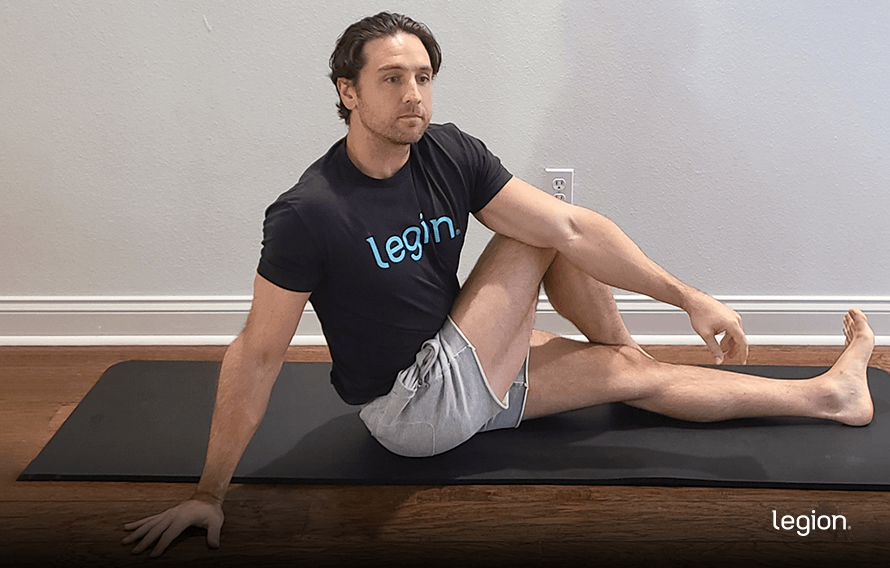
The twisting element of this pose helps to relieve side, back, and neck stiffness and increases spinal mobility. It’s important that these areas stay supple to allow you to perform many key exercises with proper form.
6. Reverse Table Pose
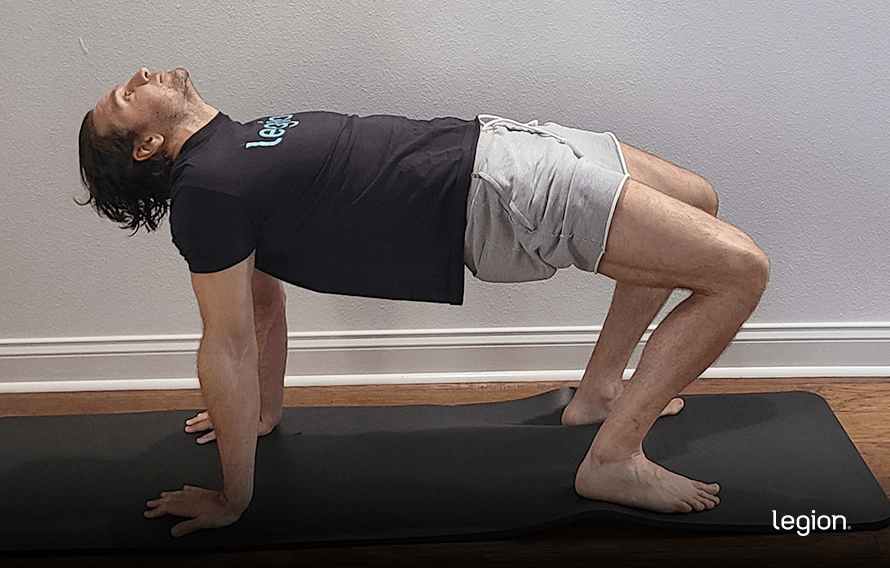
This exercise stretches the wrists, arms, shoulders, chest, abdomen, and spine, which means it’s ideal for loosening up the entire upper body and strengthening the muscles that allow you to maintain a balanced posture.
7. Thread the Needle
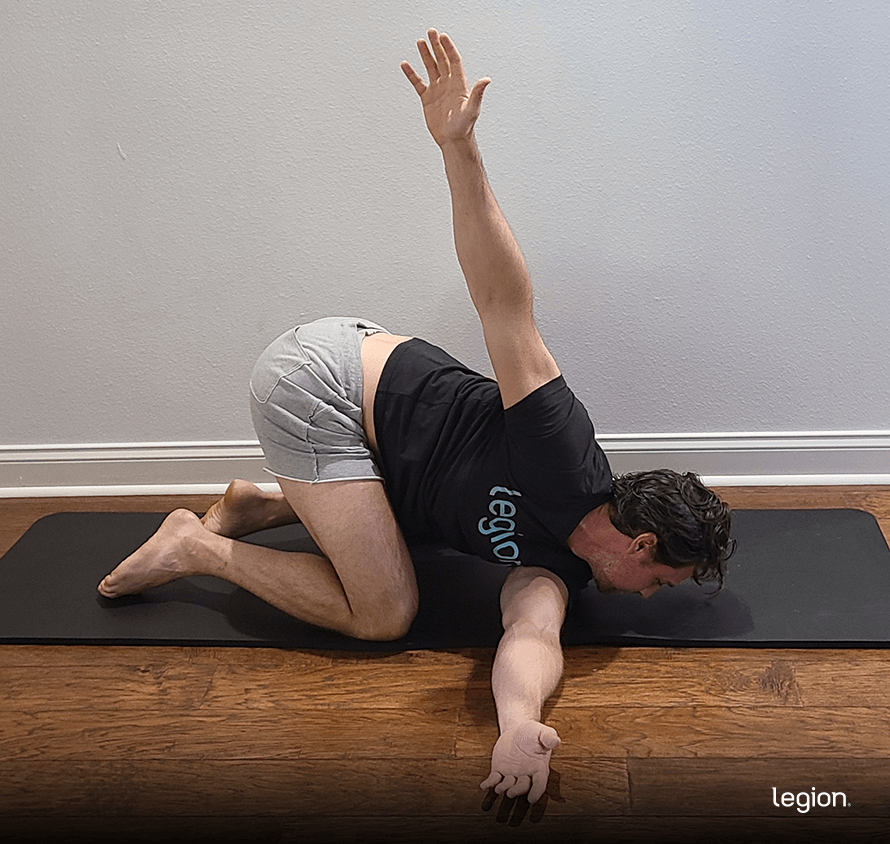
“Threading the needle” mobilizes your neck, upper back, and shoulders, which often become tight if you spend a lot of time working at a computer.
8. Eagle Arms
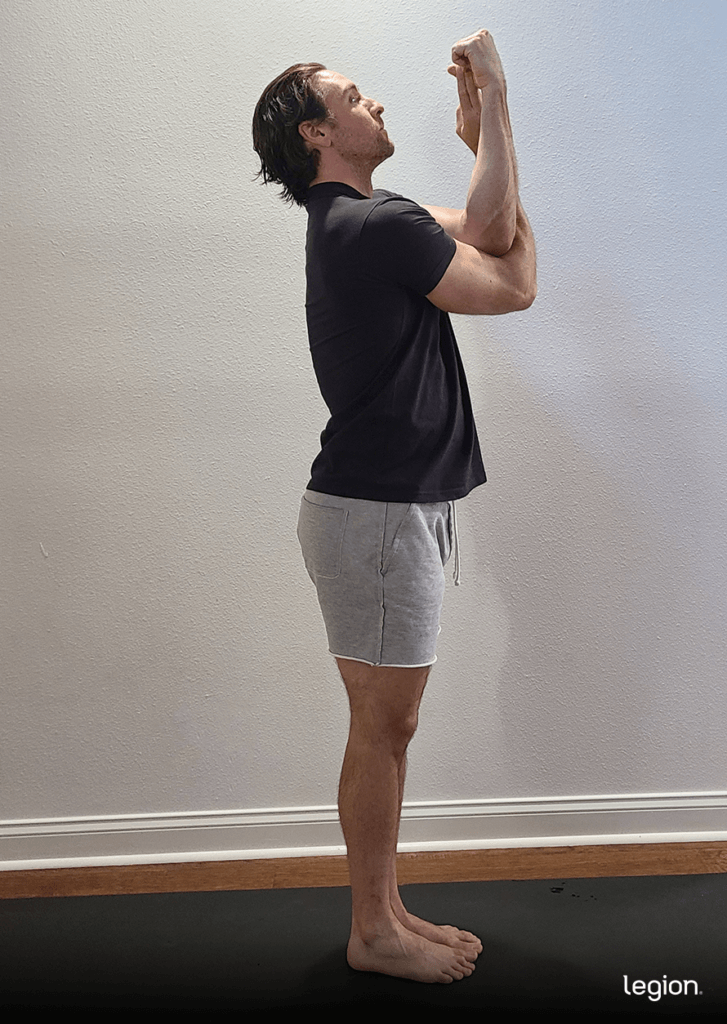
If you do a lot of “pressing” exercises such as the bench press and shoulder press, your deltoids (shoulder muscles) and rotator cuff muscles can become stiff. This pose helps to “unstick” your shoulders and upper back so you can maintain good posture more easily.
9. Cobra Pose
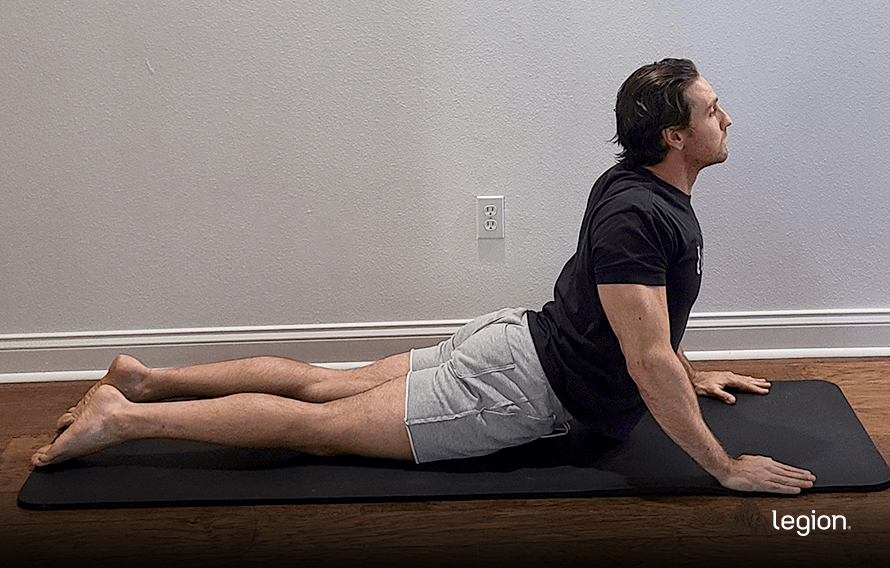
This is a simple pose that stretches out your lower back, chest, shoulders, and hip flexors.
10. Child’s Pose
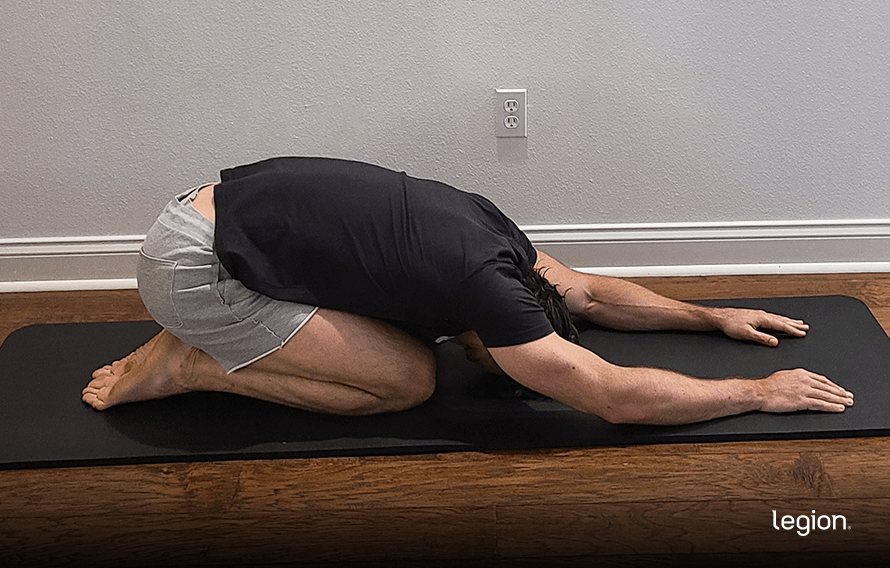
This pose doesn’t look like much, but it provides an excellent shoulder stretch that mimics the position required to do many overhead pressing exercises such as the overhead press or the dumbbell shoulder press.
+ Scientific References
- Brushøj, C., Larsen, K., Albrecht-Beste, E., Nielsen, M. B., Løye, F., & Hölmich, P. (2008). Prevention of overuse injuries by a concurrent exercise program in subjects exposed to an increase in training load: a randomized controlled trial of 1020 army recruits. The American Journal of Sports Medicine, 36(4), 663–670. https://doi.org/10.1177/0363546508315469
- Baxter, C., Mc Naughton, L. R., Sparks, A., Norton, L., & Bentley, D. (2017). Impact of stretching on the performance and injury risk of long-distance runners. Research in Sports Medicine (Print), 25(1), 78–90. https://doi.org/10.1080/15438627.2016.1258640
- Lauersen, J. B., Bertelsen, D. M., & Andersen, L. B. (2014). The effectiveness of exercise interventions to prevent sports injuries: a systematic review and meta-analysis of randomised controlled trials. British Journal of Sports Medicine, 48(11), 871–877. https://doi.org/10.1136/BJSPORTS-2013-092538
- Weldon, S. M., & Hill, R. H. (2003). The efficacy of stretching for prevention of exercise-related injury: a systematic review of the literature. Manual Therapy, 8(3), 141–150. https://doi.org/10.1016/S1356-689X(03)00010-9
- Fletcher, I. M., & Anness, R. (2007). The acute effects of combined static and dynamic stretch protocols on fifty-meter sprint performance in track-and-field athletes. Journal of Strength and Conditioning Research, 21(3), 784–787. https://doi.org/10.1519/R-19475.1
- Lowery, R. P., Joy, J. M., Brown, L. E., De Souza, E. O., Wistocki, D. R., Davis, G. S., Naimo, M. A., Zito, G. A., & Wilson, J. M. (2014). Effects of static stretching on 1-mile uphill run performance. Journal of Strength and Conditioning Research, 28(1), 161–167. https://doi.org/10.1519/JSC.0B013E3182956461
- Bradley, P. S., Olsen, P. D., & Portas, M. D. (2007). The effect of static, ballistic, and proprioceptive neuromuscular facilitation stretching on vertical jump performance. Journal of Strength and Conditioning Research, 21(1), 223–226. https://doi.org/10.1519/00124278-200702000-00040
- Rubini, E. C., Costa, A. L. L., & Gomes, P. S. C. (2007). The effects of stretching on strength performance. Sports Medicine (Auckland, N.Z.), 37(3), 213–224. https://doi.org/10.2165/00007256-200737030-00003
- Marek, S. M., Cramer, J. T., Fincher, A. L., Massey, L. L., Dangelmaier, S. M., Purkayastha, S., Fitz, K. A., & Culbertson, J. Y. (2005). Acute Effects of Static and Proprioceptive Neuromuscular Facilitation Stretching on Muscle Strength and Power Output. Journal of Athletic Training, 40(2), 94. https://doi.org/10.1016/s0162-0908(08)70360-x
- Cramer, J. T., Housh, T. J., Johnson, G. O., Weir, J. P., Beck, T. W., & Coburn, J. W. (2007). An acute bout of static stretching does not affect maximal eccentric isokinetic peak torque, the joint angle at peak torque, mean power, electromyography, or mechanomyography. The Journal of Orthopaedic and Sports Physical Therapy, 37(3), 130–139. https://doi.org/10.2519/JOSPT.2007.2389
- Herbert, R. D., de Noronha, M., & Kamper, S. J. (2011). Stretching to prevent or reduce muscle soreness after exercise. The Cochrane Database of Systematic Reviews, 7. https://doi.org/10.1002/14651858.CD004577.PUB3
- Shrier, I. (1999). Stretching before exercise does not reduce the risk of local muscle injury: a critical review of the clinical and basic science literature. Clinical Journal of Sport Medicine : Official Journal of the Canadian Academy of Sport Medicine, 9(4), 221–227. https://doi.org/10.1097/00042752-199910000-00007
- Herbert, R. D., & Gabriel, M. (2002). Effects of stretching before and after exercising on muscle soreness and risk of injury: systematic review. BMJ (Clinical Research Ed.), 325(7362), 468–470. https://doi.org/10.1136/BMJ.325.7362.468
- Smith, L. L., Brunetz, M. H., Chenier, T. C., McCammon, M. R., Houmard, J. A., Franklin, M. E., & Israel, R. G. (1993). The effects of static and ballistic stretching on delayed onset muscle soreness and creatine kinase. Research Quarterly for Exercise and Sport, 64(1), 103–107. https://doi.org/10.1080/02701367.1993.10608784
- Morton, S. K., Whitehead, J. R., Brinkert, R. H., & Caine, D. J. (2011). Resistance training vs. static stretching: effects on flexibility and strength. Journal of Strength and Conditioning Research, 25(12), 3391–3398. https://doi.org/10.1519/JSC.0B013E31821624AA
- Aquino, C. F., Fonseca, S. T., Gonçalves, G. G. P., Silva, P. L. P., Ocarino, J. M., & Mancini, M. C. (2010). Stretching versus strength training in lengthened position in subjects with tight hamstring muscles: a randomized controlled trial. Manual Therapy, 15(1), 26–31. https://doi.org/10.1016/J.MATH.2009.05.006
- Page, P. (2012). CURRENT CONCEPTS IN MUSCLE STRETCHING FOR EXERCISE AND REHABILITATION. International Journal of Sports Physical Therapy, 7(1), 109. /pmc/articles/PMC3273886/
- Hindle, K., Whitcomb, T., Briggs, W., & Hong, J. (2012). Proprioceptive Neuromuscular Facilitation (PNF): Its Mechanisms and Effects on Range of Motion and Muscular Function. Journal of Human Kinetics, 31(1), 105. https://doi.org/10.2478/V10078-012-0011-Y
- Beckett, J. R. J., Schneiker, K. T., Wallman, K. E., Dawson, B. T., & Guelfi, K. J. (2009). Effects of static stretching on repeated sprint and change of direction performance. Medicine and Science in Sports and Exercise, 41(2), 444–450. https://doi.org/10.1249/MSS.0B013E3181867B95
- La Torre, A., Castagna, C., Gervasoni, E., Cè, E., Rampichini, S., Ferrarin, M., & Merati, G. (2010). Acute effects of static stretching on squat jump performance at different knee starting angles. Journal of Strength and Conditioning Research, 24(3), 687–694. https://doi.org/10.1519/JSC.0B013E3181C7B443
- Kay, A. D., & Blazevich, A. J. (2012). Effect of acute static stretch on maximal muscle performance: a systematic review. Medicine and Science in Sports and Exercise, 44(1), 154–164. https://doi.org/10.1249/MSS.0B013E318225CB27
- Fowles, J. R., Sale, D. G., & Macdougall, J. D. (2000). Reduced strength after passive stretch of the human plantarflexors. Journal of Applied Physiology (Bethesda, Md. : 1985), 89(3), 1179–1188. https://doi.org/10.1152/JAPPL.2000.89.3.1179
- Mizuno, T., Matsumoto, M., & Umemura, Y. (2014). Stretching-induced deficit of maximal isometric torque is restored within 10 minutes. Journal of Strength and Conditioning Research, 28(1), 147–153. https://doi.org/10.1519/JSC.0B013E3182964220
- Magnusson, S. P. (1998). Passive properties of human skeletal muscle during stretch maneuvers. A review. Scandinavian Journal of Medicine & Science in Sports, 8(2), 65–77. https://doi.org/10.1111/J.1600-0838.1998.TB00171.X
- Ferreira-Júnior, J. B., Benine, R. P. C., Chaves, S. F. N., Borba, D. A., Martins-Costa, H. C., Freitas, E. D. S., Bemben, M. G., Vieira, C. A., & Bottaro, M. (2021). Effects of Static and Dynamic Stretching Performed Before Resistance Training on Muscle Adaptations in Untrained Men. Journal of Strength and Conditioning Research, 35(11), 3050–3055. https://doi.org/10.1519/JSC.0000000000003283
- Apostolopoulos, N. C., Lahart, I. M., Plyley, M. J., Taunton, J., Nevill, A. M., Koutedakis, Y., Wyon, M., & Metsios, G. S. (2018). The effects of different passive static stretching intensities on recovery from unaccustomed eccentric exercise – a randomized controlled trial. Applied Physiology, Nutrition, and Metabolism = Physiologie Appliquee, Nutrition et Metabolisme, 43(8), 806–815. https://doi.org/10.1139/APNM-2017-0841
- Garber, C. E., Blissmer, B., Deschenes, M. R., Franklin, B. A., Lamonte, M. J., Lee, I. M., Nieman, D. C., & Swain, D. P. (2011). American College of Sports Medicine position stand. Quantity and quality of exercise for developing and maintaining cardiorespiratory, musculoskeletal, and neuromotor fitness in apparently healthy adults: guidance for prescribing exercise. Medicine and Science in Sports and Exercise, 43(7), 1334–1359. https://doi.org/10.1249/MSS.0B013E318213FEFB
[ad_2]
Source link



